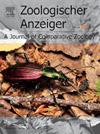Morphological and molecular analysis of four indicator species of Chironomus (Chironominae) larvae from Korea with morphological identification trait on Mouth part
IF 1.5
3区 生物学
Q2 ZOOLOGY
引用次数: 0
Abstract
Chironomid larvae are important bioindicators of freshwater ecosystems and health, but their morphological similarities often hinder species-level identification. This study employed a combined morphological and molecular approach to differentiate four common Chironomus species: Chironomus flaviplumus, Chironomus dorsalis, Chironomus nipponensis, and Chironomus plumosus. Morphological analysis revealed distinct head appendage features: C. dorsalis possesses unique mentum lateral teeth alignment, while C. flaviplumus and C. nipponensis share a distinct mandible type, and C. flaviplumus and C. plumosus have a unique pecten-epipharyngis tooth type. Phylogenetic Bayesian inference and molecular data produced a divided clade for each species group, confirming their distinct evolutionary lineagesPairwise genetics distances revealed ranges similar to previous intra- and inter-specific variation research, further supporting species delimitation. This study demonstrates the utility of combining morphological and molecular methods for accurate species identification. It paves the way for developing a pictorial key for Chironomus species, facilitating more precise biomonitoring of freshwater ecosystems.
四种具有口部形态鉴定特征的朝鲜手摇蝇幼虫的形态与分子分析
摇蚊幼虫是淡水生态系统和健康状况的重要生物指标,但其形态相似性往往阻碍物种水平的鉴定。本研究采用形态与分子相结合的方法对四种常见的Chironomus flaviplumus、Chironomus dorsalis、Chironomus nipponensis和Chironomus plumosus进行了鉴定。形态学分析表明,C. dorsalus具有独特的颏侧齿,C. flaviplumus和C. nipponensis具有独特的下颌骨类型,C. flaviplumus和C. plumosus具有独特的pecten- epynis齿型。系统发育的贝叶斯推断和分子数据为每个物种群体划分了一个分支,证实了它们独特的进化谱系,而鸟类遗传距离显示的范围与之前的种内和种间变异研究相似,进一步支持了物种划分。本研究证明了形态学和分子学相结合的方法对准确的物种鉴定的实用性。它为开发Chironomus物种的图像钥匙铺平了道路,促进了淡水生态系统的更精确的生物监测。
本文章由计算机程序翻译,如有差异,请以英文原文为准。
求助全文
约1分钟内获得全文
求助全文
来源期刊

Zoologischer Anzeiger
生物-动物学
CiteScore
2.80
自引率
7.10%
发文量
75
审稿时长
>12 weeks
期刊介绍:
Zoologischer Anzeiger - A Journal of Comparative Zoology is devoted to comparative zoology with a special emphasis on morphology, systematics, biogeography, and evolutionary biology targeting all metazoans, both modern and extinct. We also consider taxonomic submissions addressing a broader systematic and/or evolutionary context. The overall aim of the journal is to contribute to our understanding of the organismic world from an evolutionary perspective.
The journal Zoologischer Anzeiger invites suggestions for special issues. Interested parties may contact one of the editors.
 求助内容:
求助内容: 应助结果提醒方式:
应助结果提醒方式:


